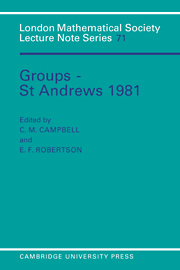Book contents
- Frontmatter
- Contents
- Preface
- Twenty-five years of Groups St Andrews Conferences
- Original Introduction
- 1 An elementary introduction to coset table methods in computational group theory
- 2 Applications of cohomology to the theory of groups
- 3 Groups with exponent four
- 4 The Schur multiplier: an elementary approach
- 5 A procedure for obtaining simplified defining relations for a subgroup
- 6 GLn and the automorphism groups of free metabelian groups and polynomial rings
- 7 Isoclinisms of group extensions and the Schur multiplicator
- 8 The maximal subgroups of the Chevalley group G2(4)
- 9 Generators and relations for the cohomology ring of Janko's first group in the first twenty one dimensions
- 10 The Burnside group of exponent 5 with two generators
- 11 The orientability of subgroups of plane groups
- 12 On groups with unbounded non-archimedean elements
- 13 An algorithm for the second derived factor group
- 14 Finiteness conditions and the word problem
- 15 Growth sequences relative to subgroups
- 16 On the centres of mapping class groups of surfaces
- 17 A glance at the early history of group rings
- 18 Units of group rings: a short survey
- 19 Subgroups of small cancellation groups: a survey
- 20 On the hopficity and related properties of some two-generator groups
- 21 The isomorphism problem and units in group rings of finite groups
- 22 On one-relator groups that are free products of two free groups with cyclic amalgamation
- 23 The algebraic structure of ℵ0-categorical groups
- 24 Abstracts
- 25 Addendum to: “An elementary introduction to coset table methods in computational group theory”
- 26 Addendum to: “Applications of cohomology to the theory of groups”
- 27 Addendum to: “Groups with exponent four”
- 28 Addendum to: “The Schur multiplier: an elementary approach”
5 - A procedure for obtaining simplified defining relations for a subgroup
Published online by Cambridge University Press: 07 September 2010
- Frontmatter
- Contents
- Preface
- Twenty-five years of Groups St Andrews Conferences
- Original Introduction
- 1 An elementary introduction to coset table methods in computational group theory
- 2 Applications of cohomology to the theory of groups
- 3 Groups with exponent four
- 4 The Schur multiplier: an elementary approach
- 5 A procedure for obtaining simplified defining relations for a subgroup
- 6 GLn and the automorphism groups of free metabelian groups and polynomial rings
- 7 Isoclinisms of group extensions and the Schur multiplicator
- 8 The maximal subgroups of the Chevalley group G2(4)
- 9 Generators and relations for the cohomology ring of Janko's first group in the first twenty one dimensions
- 10 The Burnside group of exponent 5 with two generators
- 11 The orientability of subgroups of plane groups
- 12 On groups with unbounded non-archimedean elements
- 13 An algorithm for the second derived factor group
- 14 Finiteness conditions and the word problem
- 15 Growth sequences relative to subgroups
- 16 On the centres of mapping class groups of surfaces
- 17 A glance at the early history of group rings
- 18 Units of group rings: a short survey
- 19 Subgroups of small cancellation groups: a survey
- 20 On the hopficity and related properties of some two-generator groups
- 21 The isomorphism problem and units in group rings of finite groups
- 22 On one-relator groups that are free products of two free groups with cyclic amalgamation
- 23 The algebraic structure of ℵ0-categorical groups
- 24 Abstracts
- 25 Addendum to: “An elementary introduction to coset table methods in computational group theory”
- 26 Addendum to: “Applications of cohomology to the theory of groups”
- 27 Addendum to: “Groups with exponent four”
- 28 Addendum to: “The Schur multiplier: an elementary approach”
Summary
INTRODUCTION
Given a finitely presented group G and a set of generators for a subgroup H of finite index in G, the Todd-Coxeter algorithm gives a systematic method for determining the index of H. This algorithm has been the subject of much investigation over the last fifteen years. Various computer implementations have been devised to improve its computational efficiency (see, for example, and) and it has also been modified to allow the construction of a set of defining relations for H.
The main disadvantage of this automatic approach to obtaining subgroup presentations is that, even when the index of H is small, the presentations often contain either a large number of generators, many of which are redundant, or many and long relations - or both. (See, for example.) It is possible to improve these presentations by performing a sequence of Tietze transformations (Chapter IV) to simplify the relations and remove redundant generators, but by doing so we may lose control over the subgroup generators: that is, the resulting generating set in the simplified presentation of H may not be equal to the original set of generators. Since, in some investigations, we are looking for a set of defining relations on a specific set of subgroup generators this approach is not always appropriate.
- Type
- Chapter
- Information
- Groups - St Andrews 1981 , pp. 155 - 159Publisher: Cambridge University PressPrint publication year: 1982

